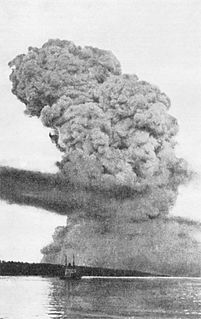
The Halifax Explosion was a maritime disaster in Halifax, Nova Scotia, Canada, which happened on the morning of 6 December 1917. The Norwegian vessel SS Imo collided with SS Mont-Blanc, a French cargo ship laden with high explosives, in the Narrows, a strait connecting the upper Halifax Harbour to Bedford Basin, causing a large explosion on the French freighter, devastating the Richmond district of Halifax. Approximately 2,000 people were killed by the blast, debris, fires or collapsed buildings, and an estimated 9,000 others were injured. The blast was the largest man-made explosion at the time, releasing the equivalent energy of roughly 2.9 kilotons of TNT (12,000 GJ).

Union Station is a major railway station and intermodal transportation hub in Toronto, Ontario, Canada. It is located on Front Street West, on the south side of the block bounded by Bay Street and York Street in downtown Toronto. The City of Toronto government owns the station building while the commuter rail operator GO Transit owns the train shed and trackage. Union Station has been a National Historic Site of Canada since 1975, and a Heritage Railway Station since 1989. It is operated by the Toronto Terminals Railway, a joint venture of the Canadian National Railway and Canadian Pacific Railway that directs and controls train movement along the Union Station Rail Corridor, the largest and busiest rail corridor in Canada.
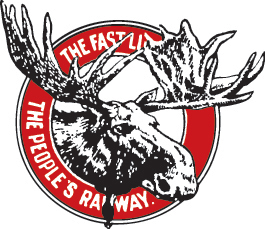
The Intercolonial Railway of Canada, also referred to as the Intercolonial Railway (ICR), was a historic Canadian railway that operated from 1872 to 1918, when it became part of Canadian National Railways. As the railway was also completely owned and controlled by the federal government, the Intercolonial was also one of Canada's first Crown corporations.
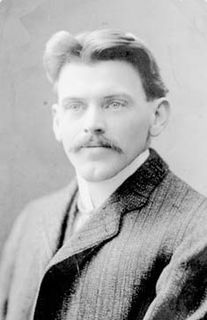
Patrick Vincent Coleman was a train dispatcher for the Canadian Government Railways who was killed in the Halifax Explosion, but not before he sent a message to an incoming passenger train to stop out of range of the explosion. Today he is remembered as one of the heroic figures from the disaster.

The North End of Halifax is a subdivision of Halifax, Nova Scotia occupying the northern part of Halifax Peninsula immediately north of Downtown Halifax. The area once included historic Africville, and parts of it were severely damaged in the Halifax Explosion during World War I. A neighbourhood with strong African Nova Scotian roots, more recently the area has undergone gentrification.
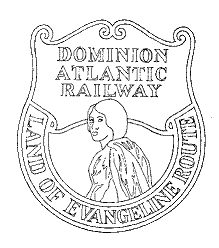
The Dominion Atlantic Railway was a historic railway which operated in the western part of Nova Scotia in Canada, primarily through an agricultural district known as the Annapolis Valley.

The South End is a neighbourhood of Halifax Regional Municipality, located on the southern half of the Halifax Peninsula in Halifax's urban centre. Quinpool Road is increasingly considered to be an arbitrary border between the South and North Ends, though Quinpool Road is also a part of the West End, and is home, for example, to the West End Baptist Church.
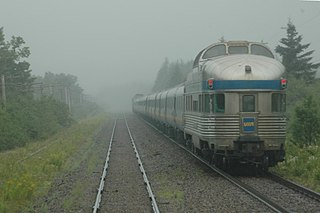
The Ocean, previously known as the Ocean Limited, is a passenger train operated by Via Rail in Canada between Montreal, Quebec and Halifax, Nova Scotia. It is the oldest continuously operated named passenger train in North America. The Ocean's schedule takes approximately 23 hours, running overnight in both directions. Together with The Canadian and Via's corridor trains, the Ocean provides a transcontinental service.
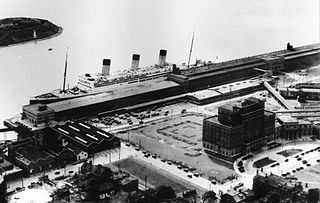
Pier 21 was an ocean liner terminal and immigration shed from 1928 to 1971 in Halifax, Nova Scotia, Canada. Over 1.5 million immigrants came to Canada through Pier 21 and it is the last surviving seaport immigration facility in Canada. The facility is often compared to the landmark American immigration gateway Ellis Island. The former immigration facility is now occupied by the Canadian Museum of Immigration, the Nova Scotia College of Art and Design as well as various retail and studio tenants.

The Halifax and South Western Railway was a historic Canadian railway operating in the province of Nova Scotia.

Halifax Harbour is a large natural harbour on the Atlantic coast of Nova Scotia, Canada, located in the Halifax Regional Municipality.

The Port of Halifax comprises various port facilities in Halifax Harbour in Halifax, Nova Scotia, Canada.

Bonaventure Station was the name of a railway station located in Montreal, Quebec, Canada. Its name was later adopted by a commercial development and a metro station.
Rockingham is a community located in Nova Scotia's Halifax Regional Municipality.

The Westin Nova Scotian is a Canadian hotel located in Halifax, Nova Scotia, owned and operated by New Castle Hotels and Resorts. It was built in 1928 by the Canadian National Railway as the Nova Scotian Hotel and after several changes of owners and names in the late 20th century became the Westin Nova Scotian in 1996.

Windsor Junction is a Canadian suburban community in Nova Scotia's Halifax Regional Municipality. It is located 15.6 km (9.7 mi) north west of the HRM urban core and 3 km (1.9 mi) north of the Bedford Basin near the communities of Waverley, Fall River and Lower Sackville.

Halifax station is an inter-city railway terminal in Halifax, Nova Scotia, Canada operated by Via Rail.

Truro station is an intercity railway station in Truro, Nova Scotia. It is operated by Via Rail.
The Nova Scotia Cotton Manufacturing Company was a cotton mill located in Halifax, Nova Scotia which was founded in 1882 and destroyed with great loss of life by the Halifax Explosion in 1917.

The Maritime Express was a Canadian passenger train. When it was launched on the first of March, 1898, it was the flagship of the Intercolonial Railway (ICR) between Halifax, Nova Scotia and Montreal, Quebec. The train was operated by the Canadian National Railway (CNR) from 1919 until 1964, when it was reduced to a regional service and its name retired.




















